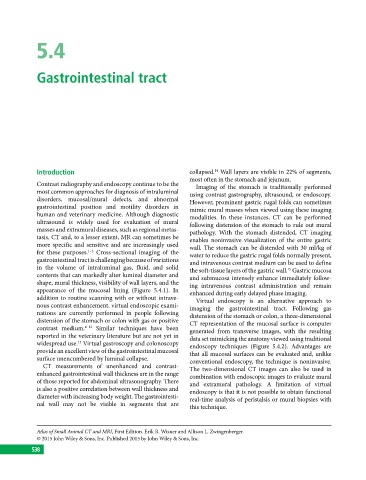Page 548 - Atlas of Small Animal CT and MRI
P. 548
5.4
Gastrointestinal tract
Introduction collapsed. Wall layers are visible in 22% of segments,
14
most often in the stomach and jejunum.
Contrast radiography and endoscopy continue to be the Imaging of the stomach is traditionally performed
most common approaches for diagnosis of intraluminal using contrast gastrography, ultrasound, or endoscopy.
disorders, mucosal/mural defects, and abnormal However, prominent gastric rugal folds can sometimes
gastrointestinal position and motility disorders in mimic mural masses when viewed using these imaging
human and veterinary medicine. Although diagnostic modalities. In these instances, CT can be performed
ultrasound is widely used for evaluation of mural following distension of the stomach to rule out mural
masses and extramural diseases, such as regional metas pathology. With the stomach distended, CT imaging
tasis, CT and, to a lesser extent, MR can sometimes be enables noninvasive visualization of the entire gastric
more specific and sensitive and are increasingly used wall. The stomach can be distended with 30 ml/kg of
1–3
for these purposes. Cross‐sectional imaging of the water to reduce the gastric rugal folds normally present,
gastrointestinal tract is challenging because of variations and intravenous contrast medium can be used to define
in the volume of intraluminal gas, fluid, and solid the soft‐tissue layers of the gastric wall. Gastric mucosa
15
contents that can markedly alter luminal diameter and and submucosa intensely enhance immediately follow
shape, mural thickness, visibility of wall layers, and the ing intravenous contrast administration and remain
appearance of the mucosal lining (Figure 5.4.1). In enhanced during early delayed phase imaging.
addition to routine scanning with or without intrave Virtual endoscopy is an alternative approach to
nous contrast enhancement, virtual endoscopic exami imaging the gastrointestinal tract. Following gas
nations are currently performed in people following distension of the stomach or colon, a three‐dimensional
distension of the stomach or colon with gas or positive CT representation of the mucosal surface is computer
contrast medium. 4–12 Similar techniques have been generated from transverse images, with the resulting
reported in the veterinary literature but are not yet in data set mimicking the anatomy viewed using traditional
widespread use. Virtual gastroscopy and colonoscopy endoscopy techniques (Figure 5.4.2). Advantages are
13
provide an excellent view of the gastrointestinal mucosal that all mucosal surfaces can be evaluated and, unlike
surface unencumbered by luminal collapse. conventional endoscopy, the technique is noninvasive.
CT measurements of unenhanced and contrast‐ The two‐dimensional CT images can also be used in
enhanced gastrointestinal wall thickness are in the range combination with endoscopic images to evaluate mural
of those reported for abdominal ultrasonography. There and extramural pathology. A limitation of virtual
is also a positive correlation between wall thickness and endoscopy is that it is not possible to obtain functional
diameter with increasing body weight. The gastrointesti real‐time analysis of peristalsis or mural biopsies with
nal wall may not be visible in segments that are this technique.
Atlas of Small Animal CT and MRI, First Edition. Erik R. Wisner and Allison L. Zwingenberger.
© 2015 John Wiley & Sons, Inc. Published 2015 by John Wiley & Sons, Inc.
538

